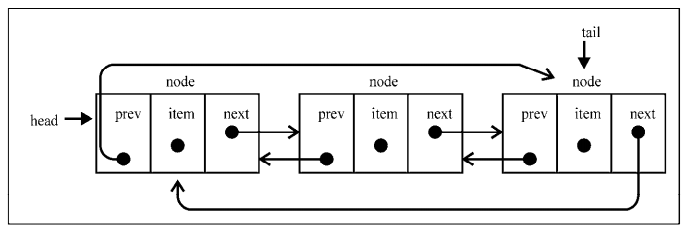每种编程语言都实现了数组,但在大多数语言中,数组大小是固定的(创建时指定),从数组起点或中间插入或移除元素的成本很高,因为后面的元素都需要挨个挪位置。
1. 链表数据结构
链表是一种动态的数据结构,用于存储有序的元素集合,可以从中任意添加或移除元素,不需要移动其他元素,可按需扩容(如众人手拉手,加个人和减个人都很简单),链表中的元素并不是连续放置的,每个元素由一个存储元素本身的节点,和一个指向下一个元素的引用(也称指针或链接)组成:

数组可以直接访问任何位置的元素(可以理解为是物理电路,访问任意位置的元素都一样快),而想要访问链表中间的元素,就需要从表头开始迭代链表中的节点,挨个寻找,就像藏宝游戏,不断地根据线索寻找。
各自优势:
- 链表:增、删
-
1.1 创建链表
append(element):向列表尾部添加一个新的项。
- insert(position, element):向列表的特定位置插入一个新的项。
- remove(element):从列表中移除一项。
- indexOf(element):返回元素在列表中的索引。如果列表中没有该元素则返回-1。
- removeAt(position):从列表的特定位置移除一项。
- isEmpty():如果链表中不包含任何元素,返回true,如果链表长度大于0则返回false。
- size():返回链表包含的元素个数。与数组的length属性类似。
toString():由于列表项使用了Node类,就需要重写继承自JavaScript对象默认的toString方法,让其只输出元素的值。
function LinkedList() {// 单个节点类,表示要加入到链表中的项let Node = function (element) {this.element = element;this.next = null;};let length = 0; // 内部私有变量,记录链表长度let head = null; // 头指针/*** 向链表尾部添加一个新的项* 两种场景:链表为空,添加的是第一个元素;链表不为空,向其追加元素。** @param element*/this.append = function (element) {let node = new Node(element), current;if (head === null) {head = node;} else {current = head;// 从表头开始循环找到最后一项while (current.next !== null) {current = current.next;}// 把节点链接到最后一项的 next 上current.next = node;}length++; // 更新链表长度};/*** 从任意位置移除元素并返回被移除的元素* 两种场景:移除第一个元素;移除第一个以外的任一元素。* 被移除的元素被丢弃在计算机内存中,等待被垃圾回收器清理。** @param {number} position* @returns {element|null}*/this.removeAt = function (position) {// 检查是否越界if (position >= 0 && position < length) {let current = head,previous,index = 0;// 分两种情况:表头和非表头if (position === 0) {head = current.next;} else {// position 的前一个位置时终止循环while (index++ < position) {previous = current;current = current.next;}// 上下节点进行链接,跳过中间将被移除的 current 节点previous.next = current.next;}length--;return current.element;} else {return null;}};/*** 在任意位置插入元素** @param {number} position* @param element* @returns {boolean}*/this.insert = function (position = 0, element) {// 检查是否越界,注意这里包含了空链表时的情形if (position >= 0 && position <= length) {let node = new Node(element),current = head,previous,index = 0;if (position === 0) {node.next = current;head = node;} else {while (index++ < position) {previous = current;current = current.next;}node.next = current; // 即新节点插入到目标位置的前面,这里current可能是nullprevious.next = node;}length++;return true;} else {return false;}};/*** 把 LinkedList 对象转换成字符串** @returns {string}*/this.toString = function () {let current = head,string = '',index = 0;while (current) {string += index++ + ': ' + current.element + (current.next ? '\n' : '');current = current.next;}return string;};/*** 查找给定元素的索引,找不到则返回 -1** @param element* @returns {number}*/this.indexOf = function (element) {let current = head,index = -1;while (current) {index++;if (element === current.element) {return index;}current = current.next;}return -1;};/*** 移除给定的元素** @param element* @returns {element|null}*/this.remove = function (element) {const index = this.indexOf(element);return this.removeAt(index);};/*** 链表是否为空* @returns {boolean}*/this.isEmpty = function () {return length === 0;};/*** 链表大小* @returns {number}*/this.size = function () {return length;};/*** 获取表头* 方便实例外部访问和迭代链表** @returns {element|null}*/this.getHead = function () {return head;};}
1.2 双向链表

function DoublyLinkedList() {let Node = function (element) {this.element = element;this.next = null;this.prev = null;};let length = 0;let head = null;let tail = null;/*** 从任意位置移除元素** @param position* @returns {element|null}*/this.removeAt = function (position) {if (position >= 0 && position < length) {let current = head,previous,index = 0;if (position === 0) { // 第一项head = current.next;// 如果只有一项,需要更新tailif (length === 1) {tail = null;} else {head.prev = null;}} else if (position === length - 1) { // 最后一项current = tail;tail = current.prev;tail.next = null;} else {while (index++ < position) {previous = current;current = current.next;}previous.next = current.next;current.next.prev = previous;}length--;return current.element;} else {return null;}};/*** 从任意位置添加节点** @param {number} position* @param element* @returns {boolean}*/this.insert = function (position, element) {if (position >= 0 && position <= length) {let node = new Node(element),current = head,previous,index = 0;if (position === 0) { // 在第一个位置添加if (!head) { // 当前链表为空head = node;tail = node;} else {node.next = current;current.prev = node;head = node;}} else if (position === length) { // 最后一项current = tail;current.next = node;node.prev = current;tail = node;} else {while (index++ < position) {previous = current;current = current.next;}previous.next = node;node.next = current;current.prev = node;node.prev = previous;}length++;return true;} else {return false;}};// 其他方法和单向链表类似}
1.3 循环链表
循环链表 CircularLinkedList 可以只有单向引用,也可以像双向链表一样有双向引用。
单向循环链表中:循环链表中 tail.next 指向 head。
双向循环链表中:tail.next 指向 head,head.prev 指向 tail。
2. 链表相关问题
2.1 判断链表是否存在环形
```javascript // https://leetcode.com/problems/linked-list-cycle/
// 1. 暴力解法(brute force): 迭代节点, 存储或进行标记, 如果遇见已经存在的记录, 则说明存在环形
// 2. 快慢双指针(龟兔赛跑): // slow速度为1, fast为2, 若fast遇见了slow(地球是圆的), 则说明存在环形
/**
- Definition for singly-linked list.
- function ListNode(val) {
- this.val = val;
- this.next = null;
- } */
/**
- 判断链表是否存在环形 *
- @param {ListNode} head
@return {boolean} */ const hasCycle = function (head) { let slow = head, fast = head;
while (fast !== null && fast.next !== null) { slow = slow.next; fast = fast.next.next; if (slow === fast) { return true; } } return false; }; ```
2.2 求两个链表交集时的节点
```javascript // https://leetcode.com/problems/intersection-of-two-linked-lists/
// 1. 暴力解法(brute force): 使用数组或者set存储一条链表所有节点,然后迭代第二条链表进行查找是否存在(略)
// 2. 双指针 two pointers // 两个链表指针同时从各自表头移动, 速度一致, 当较短的链表(A)跑到头后, 较长的链表(B)就开始顺便重定向头部指针, // 此后B的前后两个指针之差始终等于A的总长度, // 然后等到B的后指针也跑到头后, 再同时从A和B的左侧指针开始迭代比较是否相等,找出交点.
// Time complexity : O(m+n)O(m+n). // Space complexity : O(1)O(1).
/**
- Definition for singly-linked list.
- function ListNode(val) {
- this.val = val;
- this.next = null;
- } */
/**
- 求两个链表交集时的节点 *
- @param {ListNode} headA
- @param {ListNode} headB
@return {ListNode|null} */ const getIntersectionNode = function (headA, headB) { let a = headA, b = headB;
while (a !== null || b !== null) { if (a !== null) { a = a.next; } else { headB = headB.next; }
if (b !== null) { b = b.next; } else { headA = headA.next; } }
while (headA !== headB) { headA = headA.next; headB = headB.next; }
return headA; }; ```

